You should install grab bars in common injury-prone areas like bathrooms, near the toilet, shower, and tub, to support safe movement and prevent falls. Place them along hallways, entrances, staircases, and ramps for added stability, especially when maneuvering steps or uneven surfaces. Proper placement, secure anchoring, and choosing the right type are vital. To find out the best spots and installation tips, keep exploring more helpful advice for your safety.
Key Takeaways
- Install grab bars near toilets and showers to support safe sitting, standing, and prevent falls in wet areas.
- Mount grab bars 33-36 inches above floors or tubs for optimal grip and support.
- Place grab bars along hallways and entrances for added stability during transitions.
- Use angled or fold-down grab bars in showers to maximize space and accessibility.
- Securely anchor grab bars into wall studs or reinforced areas to ensure reliable support.
Bathroom Shower and Tub Areas
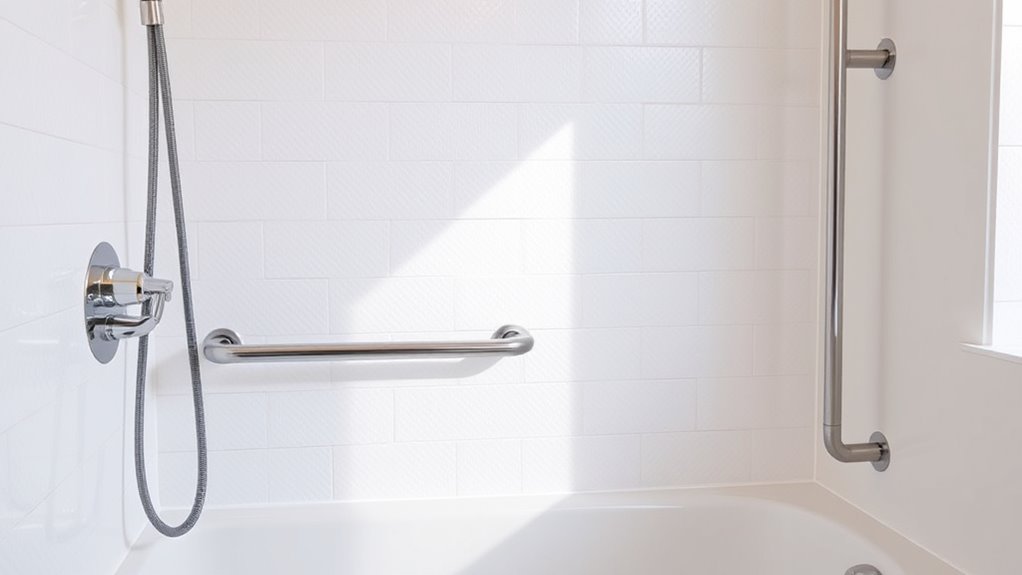
When installing grab bars in bathroom shower and tub areas, safety should be your top priority. Choosing the right grab bar types is essential; options include straight bars, angled bars, and fold-down models, each suited for different needs. Proper installation height is vital—ideally, grab bars should be mounted 33 to 36 inches above the shower floor or tub edge for maximum support. Ensure they are securely anchored into wall studs or reinforced behind tiles to handle weight and prevent accidents. Avoid placing grab bars where they might interfere with shower doors or fixtures. Proper positioning and sturdy installation enhance safety and independence, helping prevent slips and falls. Additionally, staying informed about data privacy challenges can help ensure that safety features and personal data are protected during the installation process. Always follow manufacturer guidelines and local building codes for the best results.
Near the Toilet
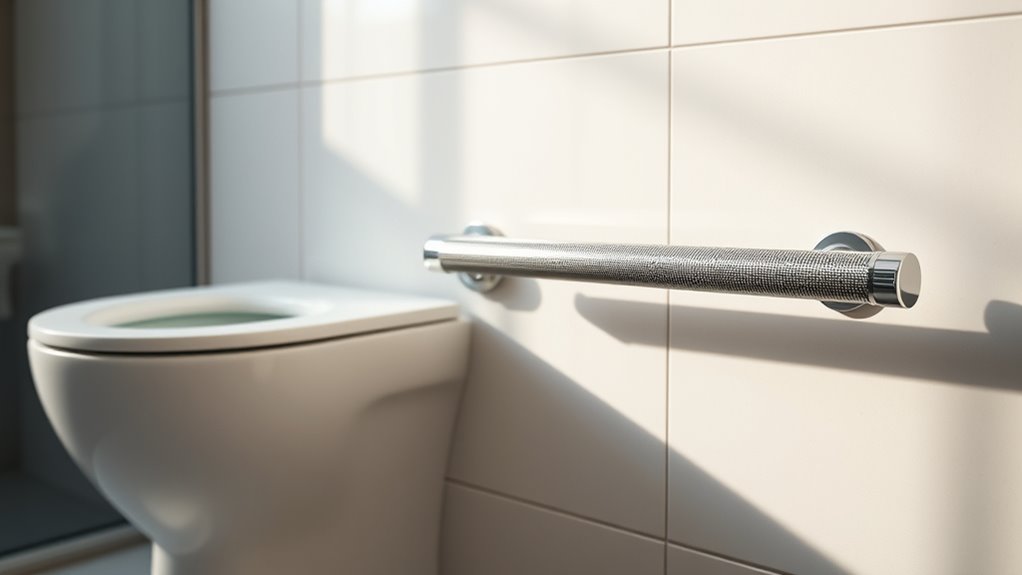
Installing grab bars near your toilet makes it easier to reach when you need support. They help prevent falls and provide a sense of security. With easy access, you can use the bathroom more independently and safely. Using a self-watering system can also assist individuals who have difficulty maintaining proper moisture levels in plants or other needs around the home.
Easy Reach Access
Easy reach access near the toilet guarantees safety and independence for users with mobility challenges. Properly placed grab bars provide essential support, especially when visual cues help identify their location quickly. When you install grab bars within easy reach, you reduce the need to stretch or reach awkwardly, which can strain grip strength. Imagine standing up or sitting down with confidence, knowing the bar is right there for stability. Visual cues like contrasting colors make grab bars more noticeable, ensuring you can find them effortlessly. The right placement also supports a natural movement flow, preventing slips or falls. Keep these in mind:
- Positioned at hand level for quick access
- Clearly visible through contrasting colors
- Located close to the toilet for seamless support
- Enhanced safety features such as textured surfaces can further improve grip and security.
Prevents Falls Safely
Properly positioned grab bars near the toilet play a crucial role in preventing falls and ensuring safety. In bathroom safety, falls around the toilet are common, especially for seniors or those with limited mobility. Installing sturdy grab bars gives you reliable support when sitting down or standing up, reducing the risk of slips and tumbles. Make sure they are securely anchored to the wall and placed within easy reach. This simple addition enhances fall prevention and boosts confidence during bathroom use. By incorporating grab bars at strategic locations, you create a safer environment that minimizes hazards. Prioritizing bathroom safety with well-installed grab bars helps you stay independent and prevents injuries caused by falls near the toilet. Additionally, understanding space optimization can help ensure grab bars are placed in optimal locations without compromising bathroom layout.
In the Hallways and Entrances
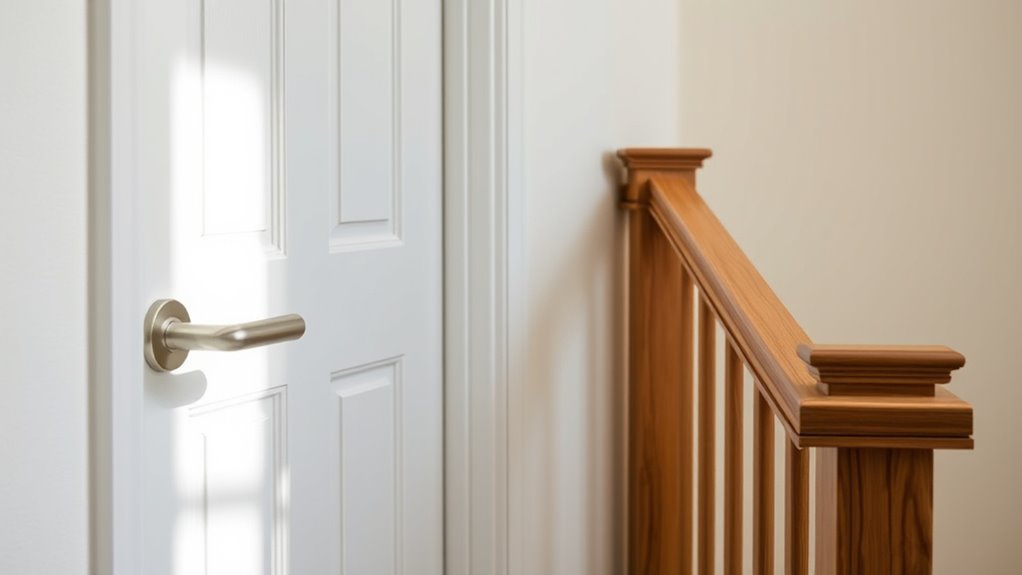
Because hallways and entrances are key areas where slips and falls often occur, adding grab bars can substantially improve safety. These spots are high-traffic zones where elderly safety and fall prevention are especially important. Installing grab bars near doorways or along walls provides support when entering or exiting, reducing the risk of accidents. Visualize yourself stepping into a home or building and immediately having a sturdy handhold to steady your balance. Incorporating high-quality materials ensures that grab bars are durable and reliable for everyday use.
- A grab bar mounted beside the front door for quick support
- Horizontal bars along the hallway walls for stability during walking
- Non-slip mats near entrance thresholds for added grip
These simple additions help prevent falls, making hallways and entrances safer for everyone, especially seniors.
Staircases and Ramps
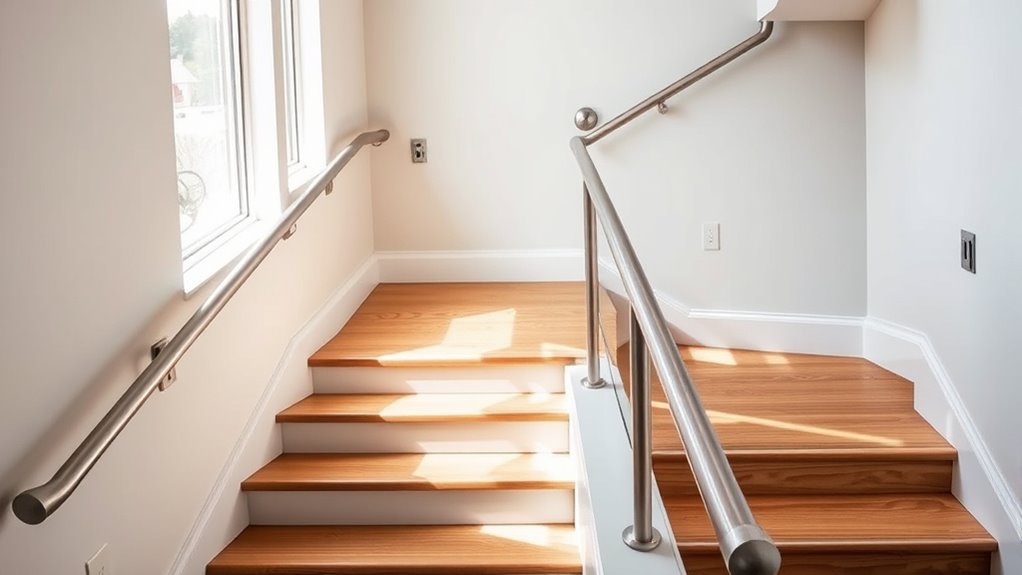
Staircases and ramps are common areas where falls can happen, especially if handholds aren’t available or well-placed. Proper handrail design is essential for safety, providing support and stability. Choose handrails with ergonomic shapes that fit comfortably in your hand, encouraging a secure grip. The grip materials also matter; options like rubber or textured surfaces improve friction, reducing slips. Install handrails at the right height—typically between 34 and 38 inches—and ensure they run continuously along the entire staircase or ramp. Avoid sharp edges or slippery materials that can compromise grip. Well-designed handrails with suitable grip materials offer confidence during use, helping prevent accidents and making staircases and ramps safer for everyone. Incorporating ergonomic grip features can further enhance safety by accommodating different hand sizes and reducing fatigue during use.
Bedroom Access Points
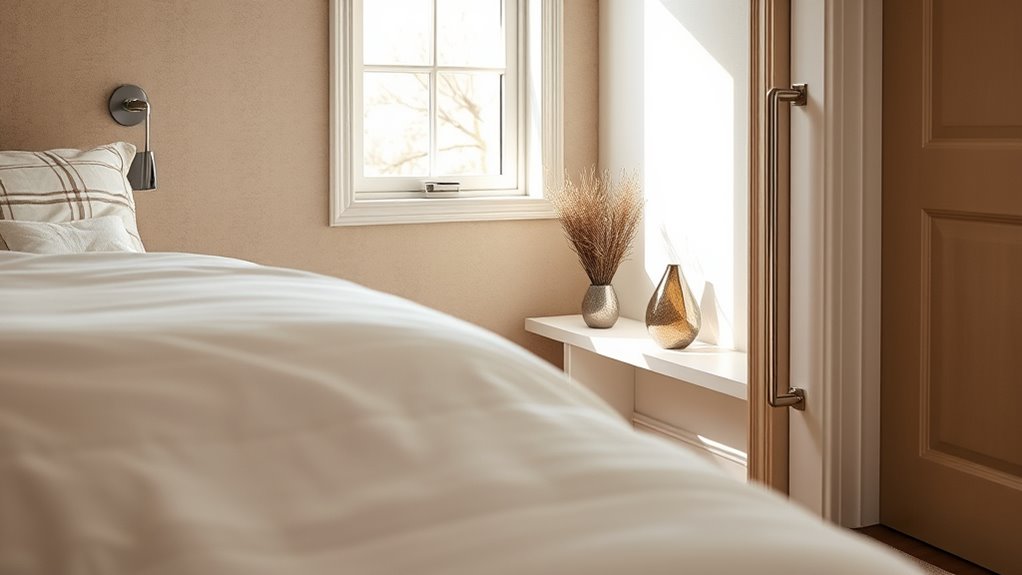
Ensuring easy and safe access to the bedroom is essential for all users, especially those with mobility challenges. Proper grab bars near the sleeping area can prevent falls and improve bedside safety. Consider installing grab bars on the wall beside the bed or near the doorway for stable support when entering or exiting. Visualize reaching for a secure grip in the dark, or steadying yourself when getting out of bed. Additionally, selecting durable and high-quality grab bars can ensure long-lasting support and safety in the bedroom environment.
Other High-Risk Zones in the Home
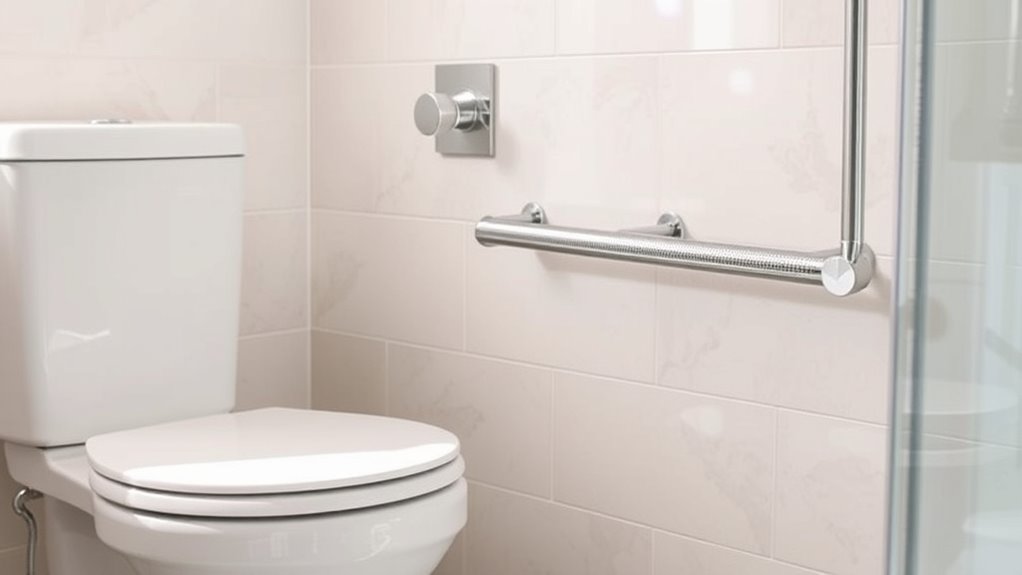
While grab bars near the bed improve safety at night, other areas in your home also pose significant fall risks. The kitchen, outdoor pathways, and entryways are common danger zones. You should consider installing grab bars and non-slip mats to prevent slips and falls. Outdoor pathways can become hazardous in bad weather, so adding sturdy handrails and good lighting helps. Kitchens often have slick floors and clutter, increasing fall risk, so keep walkways clear. Here’s a quick overview:
| Area | Risk Factors | Safety Tips |
|---|---|---|
| Kitchen | Slippery floors, clutter | Use non-slip mats, organize |
| Outdoor paths | Wet, uneven surfaces | Add handrails, repair uneven ground |
| Bathroom | Water, wet surfaces | Install grab bars, mats |
| Entryways | Steep stairs, clutter | Use handrails, declutter |
Additionally, understanding fall prevention strategies can further help reduce accidents in these high-risk zones.
Frequently Asked Questions
What Materials Are Best for Grab Bars in Humid Areas?
When choosing materials for grab bars in humid areas, you want options with excellent material durability and corrosion resistance. Stainless steel is your best choice because it withstands moisture without rusting, ensuring longevity. Aluminum also works well due to its lightweight and corrosion-resistant properties. Avoid materials prone to corrosion, like certain plastics or metals that rust easily. Selecting high-quality, corrosion-resistant materials keeps your grab bars safe and durable over time.
How Do I Determine the Correct Height for Installation?
Imagine you’re setting the stage for safety, like an architect designing a sturdy foundation. To find the right height, follow height guidelines—typically, install grab bars 33 to 36 inches above the floor—and use installation tips like guaranteeing they’re secure and level. Consider your height and mobility needs, adjusting accordingly. Proper placement ensures comfort and safety, making daily tasks easier and reducing fall risks.
Can Grab Bars Support All User Weights Safely?
You might wonder if grab bars can support all user weights safely. Generally, they are designed with specific weight capacities that meet safety standards, usually supporting at least 250 pounds. Always check the manufacturer’s specifications and verify installation follows safety standards. Properly mounted grab bars provide reliable support, but avoid exceeding weight limits to ensure safety and prevent accidents. Regularly inspect them for wear or damage for ongoing safety.
Are There Any Building Codes for Grab Bar Installation?
Did you know that over 80% of bathroom injuries happen due to improper grab bar installation? Building code compliance is essential to guarantee safety, so you should always follow installation guidelines set by local authorities. These codes specify height, placement, and support requirements, helping you avoid penalties and ensure the grab bars are secure. Always check with your local building department before installing grab bars to meet regulations and promote safety.
How Do I Maintain and Clean Grab Bars Effectively?
To keep your grab bars clean and well-maintained, follow simple cleaning techniques like using a damp cloth with mild soap regularly. Avoid harsh chemicals that can damage the surface. Maintenance tips include checking for looseness and tightening any fittings as needed. Keeping the bars dry and free of debris guarantees safety and longevity. Regular cleaning and inspections help your grab bars stay secure and effective for everyday use.
Conclusion
By thoughtfully placing grab bars around your home, you create quiet anchors of support that gently guide you through daily shifts. These subtle touches help maintain your independence and safety, gently easing the uncertainties of movement. When chosen with care and installed in key spots, they become trustworthy companions, offering reassurance without fuss. In embracing these unobtrusive aids, you craft a space where confidence and comfort quietly flourish, inviting peace in every step you take.





